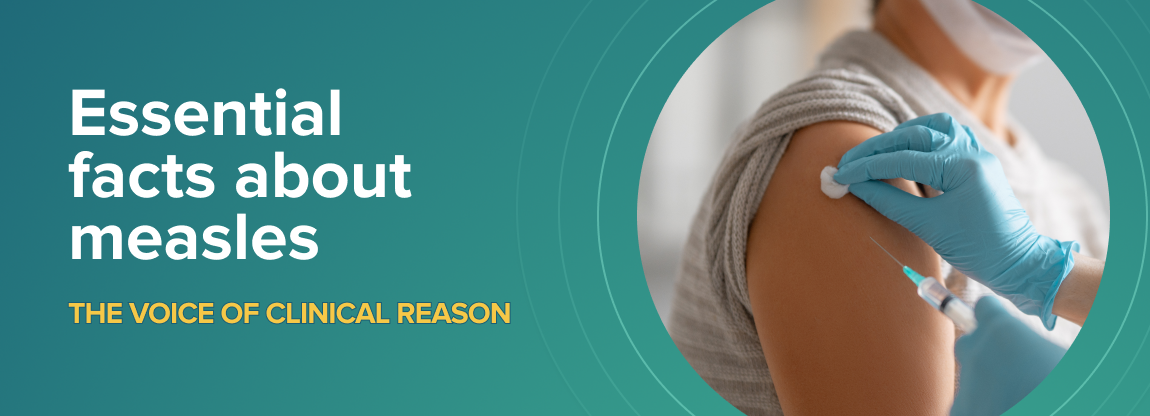Essential facts about measles: how global setbacks are reviving a preventable disease
Once on the verge of global elimination, measles is making an alarming comeback.
This vaccine-preventable disease, known for its fever, cough, conjunctivitis, and signature rash, is once again claiming lives and straining health systems. Its resurgence is tied to a complex mix of global challenges. Declining vaccination rates, limited access to healthcare, and fallout from the COVID-19 pandemic have created ideal conditions for measles to return.
Chapter 211 of Harrison’s Principles of Internal Medicine, 22nd Edition, explores this resurgence in depth. Below, we’ve highlighted some of the most essential takeaways.
A public health victory under threat
Measles was once a public health success story. Between 2000 and 2022, the estimated number of measles-related deaths dropped by 82%, falling from 772,854 to 136,216 annually. That progress was powered by expanded vaccine access, second-dose coverage, and large-scale immunization campaigns. Over this same period, an estimated 57.2 million lives were saved through measles vaccination efforts.
In 2016, the Americas became the first World Health Organization (WHO) region to declare measles eliminated. That status was, unfortunately, short-lived. By 2018, endemic transmission had returned, and the region lost its elimination designation. No WHO region has since achieved and sustained measles elimination. The lesson is clear: without consistently high vaccination coverage, measles can and will return.
The ripple effects of the COVID-19 pandemic
The pandemic did not just bring a new disease threat. It disrupted routine health services around the world, including immunization programs. In 2021 alone, nearly 40 million children missed a dose of the measles vaccine. Of those, 25 million missed their first dose entirely.
The result was a sharp increase in outbreaks. Measles reemerged in 22 countries in 2021 and in 37 countries the following year. Global case numbers rose by 18%, and measles-related deaths jumped by 43% over that time. These statistics are more than numbers; they represent missed opportunities, unprotected communities, and preventable tragedies.
Why measles spreads so easily
Measles is one of the most contagious viruses known to science. In communities where less than 90% of the population is vaccinated, outbreaks can spread rapidly. The virus is highly infectious even before symptoms become visible, which makes it difficult to contain without strong immunization coverage.
A single case can spark an outbreak, and in close-contact settings like households, schools, and healthcare facilities, the secondary attack rate often exceeds 90%. What’s more, because there are no animal reservoirs for measles, the virus relies entirely on human-to-human transmission. That means it can be stopped with vaccines, but only if enough people are immunized.
Who is at risk today?
Unvaccinated children remain the most vulnerable. In countries with low routine immunization coverage, infants and young children are frequently the first to be affected. However, the age profile is shifting. As more children are vaccinated and fewer early-childhood cases occur, measles outbreaks increasingly affect older children, adolescents, and even adults who may have missed routine doses.
For people with weakened immune systems, measles is especially dangerous. Without a typical immune response, they may not develop the characteristic rash, making diagnosis harder. These individuals face a much higher risk of severe illness or death and, because they may remain contagious for longer periods, they also contribute to wider transmission.
Public trust and the challenge of vaccine confidence
One of the ironies of successful public health campaigns is that they can make the diseases they prevent feel less urgent. In some communities, concern about measles has faded. In its place, fears about vaccine safety have taken root. These fears, often based on misinformation, have contributed to vaccine hesitancy that puts entire populations at risk.
Restoring trust is crucial and that means more than trying to show people the numbers. It means building meaningful relationships, listening to concerns, and tailoring outreach to reflect the values and experiences of local communities. Effective vaccine messaging is personal, transparent, and inclusive.
A renewed call to action
The path forward is challenging but clear. Despite its global resurgence, the virus itself has not changed; measles can still be prevented with two doses of a safe and effective vaccine. It remains antigenically stable, which means the same vaccines developed decades ago still provide reliable protection.
What has changed is our ability to reach every child. Global efforts, including those led by the Measles and Rubella Partnership, continue to provide essential support to countries working to catch up on missed vaccinations. These programs are key to reversing recent setbacks.
Preventing measles is not only about protecting individual lives. It’s also a test of our commitment to health equity and our ability to respond to global health threats with urgency, coordination, and compassion.
Vaccine hesitancy and global health disruptions have reawakened a disease we thought was nearly gone. Chapter 211 of Harrison’s Principles of Internal Medicine 22nd Edition offers a deep, authoritative look — one of many inside the new book launching in 2025.
Pre-order your physical copy to explore this chapter in full and go deeper into the global health challenges addressed throughout the fully updated 22nd edition of Harrison’s Principles of Internal Medicine.
There are now two ways to access Harrison’s:
- Order your physical copy online.
- Explore the full edition of Harrison’s and more with AccessMedicine – available via institutional access or free trial.

